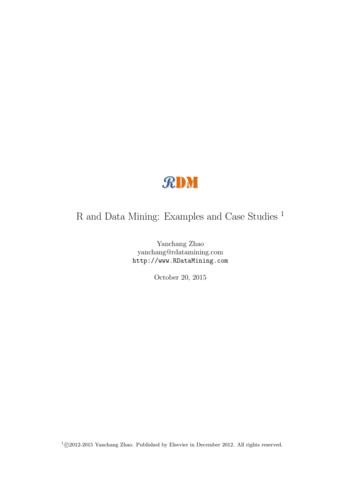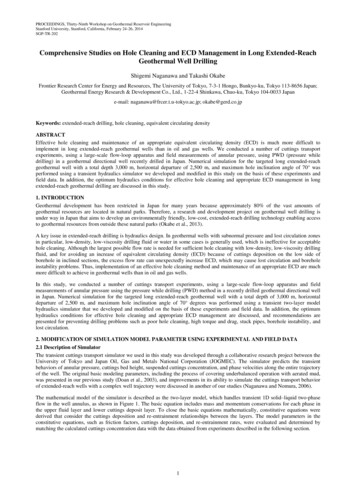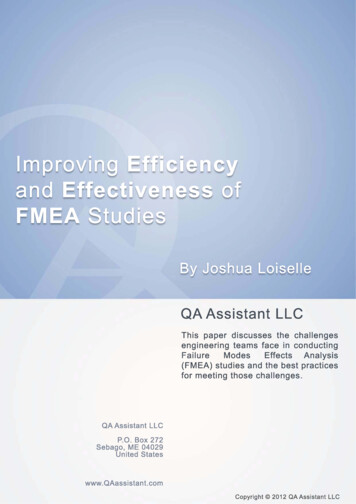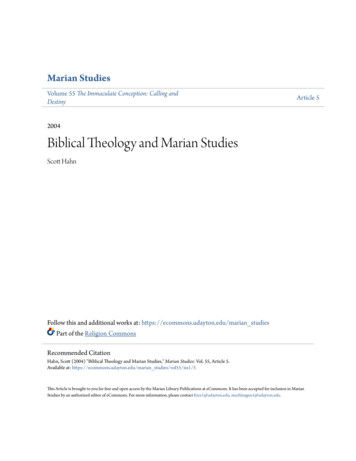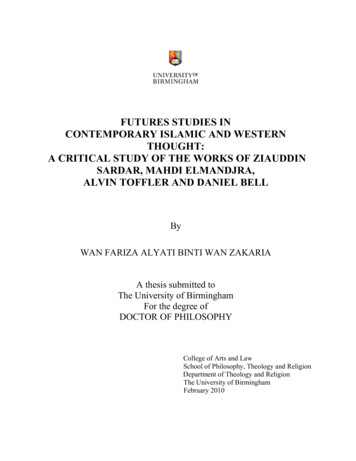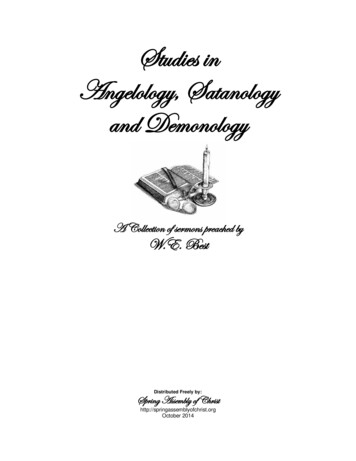
Transcription
Studies inAngelology, Satanologyand DemonologyA Collection of sermons preached byW.E. BestDistributed Freely by:Spring Assembly of Christhttp://springassemblyofchrist.orgOctober 2014
Studies inAngelology, Satanologyand DemonologyA Collection of sermons preached by W.E. BestTable of ContentsAngelologySection One: IntroductionSection Two: Classification of the Heavenly CreaturesSection Three: Lucifer’s FallSection Four: Satan’s FormSection Five: Satan’s CharacterSatanology Part 1Satanology Part 2Satanology Part 3Demonology Part 1Demonology Part 2Demonology Part 3Distributed Freely by:Spring Assembly of Christhttp://springassemblyofchrist.orgOctober 2014
AngelologyW.E. BestSection OneIntroduction“Having become as much better than the angels, as He has inherited a moreexcellent name than they. For to which of the angels did He ever say, THOUART MY SON, TODAY I HAVE BEGOTTEN THEE? And again, I WILL BE AFATHER TO HIM, AND HE SHALL BE A SON TO ME? And when He againbrings the first-born into the world, He says, AND LET ALL THE ANGELS OFGOD WORSHIP HIM. And of the angels He says, WHO MAKES HIS ANGELSWINDS, AND HIS MINISTERS A FLAME OF FIRE” (Heb. 1:4-7 NASB).“But to which of the angels has He ever said, SIT AT MY RIGHT HAND, UNTIL IMAKE THINE ENEMIES A FOOTSTOOL FOR THY FEET?” (Heb. 1:13 NASB).The branch of theological thought known as Angelology must be linked with therelated themes of Satanology and Demonology. Each of the three themes takesthe student into the realm of the supernatural. Angelology is in the heavenlyrealm. Satanology is in the sphere of darkness. Demonology is in the realm ofthe infernal. Increasing demonization produces crescendoing apostasy. Thecommon thought of progressive thinking should be avoided, because it goeshand in hand with progressive deafness to the word of God. Satan was at onetime an angel; therefore, we will begin the discussion with Angelology.In the record of the creation of the heavens and the earth, nothing is stated aboutthe creation of the angels (Gen. 1). Since the angels rejoiced when God createdthe earth, they already existed (Job 38:4-7). Paganism with its wild speculationabout angels has created distaste for them. Religious cults with their ownAngelology have caused many to shy away from this teaching. Because there isan unlawful intrusion into the unseen world, Paul warned against mysticism thatinvolves angels (Col. 2:8-19). This interposition is a warning against angelicidolatry, spiritism, and occultism in general. It cautions against anything that failsto make Jesus Christ preeminent. The Devil knows the tendency of God’s peopleto be suspicious of what is embraced and magnified by occultists; therefore, heuses all forms of advertisement to exploit occultism. Thus, he advances error andkeeps many Christians from studying a subject that would enhance their spirituallives. The prince of darkness requires the darkness of ignorance in which towork. Therefore, believers should not neglect any subject that is mentioned about300 times in God’s word.1
To the Christian, after God, Satan is the next largest factor in the universe. Thereis nothing our age needs more, apart from the knowledge of God, than a Biblicalview of what the Scriptures teach concerning Satan. Evil goes beyond thedepravity of man to a spiritual foe who is none other than Satan, the primarysource of evil. This supernatural being hates God and is bent on turning mankindagainst God, if it were possible.The subject of Satanology has the support of facts. Philosophies, theologies ofmen, cosmology, and hypotheses alike change, but Biblical facts never change.To deny that Christ lived and died and that He spoke of a personal Devil who isthe god of this age is to reveal one’s ignorance of facts. We have the crushingfacts of a world reeking in crime, lust, war, misery, etc., which are causing men’shearts to fail them because of the things coming to pass. This world is lying in theevil one (I John 5:19).Angels and demons should be distinguished. Angels are ministering spirits sentforth to minister to those who shall be the heirs of salvation (Heb. 1:14). Angelsare never said to possess human beings. Christians have the Spirit of God, notangels, dwelling within. Demons are false angels (Gal. 1:6-9). They possess andinfluence human beings.Fallen angels roam over the earth and in the air (Job 2:1, 2). How can the fallenangels roam over the earth and in the air if they are kept in chains for the Day ofJudgment (II Pet. 2:4)? The fallen angels were consigned for preservation toTartarus in pits of darkness being kept in custody or legal restraint for judgment(II Pet. 2:4). “And the angels who did not keep their own domain, but havingdeserted their own habitation, He has reserved in eternal bonds under darknessfor the judgment of the great day” (Jude 6—translation). These two verses ofScripture do not indicate that fallen angels cannot roam the earth. Theypossessed the Gadarene; and when they were cast out, they entered the swineand caused the swine to run into the deep (Luke 8:30-33). The abyss will beopened, and they will come out of the abyss (Rev. 9:1-11). There will be a greatamount of demon activity before the coming of Jesus Christ as King.All specific demonization referred to after the ascension of Jesus Christ is foundin relation to the conclusion of this age. While there are many references todemon activity and unclean spirits in the four Gospels, all the other referencesbeginning with Acts through Revelation point to the activity of demons in the lastdays. Therefore, we are justified in concluding that like the days of our Lord’searthly ministry, demon activity will be powerful and violent toward the conclusionof this age. Unclean spirits, evil spirits, and demons are synonymous in theGospels. The adjectives “unclean” and “evil” in reference to spirit are descriptiveadjectives of these spirits or demons.Creation began in the angelic realm, and apostasy began with one of the createdangels. The word “angel,” which means messenger, is the transliteration of the2
Greek angelos and the Hebrew malak. This term is not only generic in that it isapplied to all orders of created spirits, but it is also expressive of their office andservice. The word is applied various ways: It is used of prophets (Hag. 1:13),John the Baptist (Mal. 3:1), disciples (Luke 9:52), the representatives of theseven assemblies in Asia (Rev. 2; 3), and those who were sent from John theBaptist (Luke 7:24). The word is also used of providential circumstances,because these convey a message. God makes winds His messengers (Ps.104:4; 148:8). It is also applied to Jesus Christ. He is frequently referred to as theangel of Jehovah (Gen. 16:7; Ex. 3:2; Judg. 6:12). He is seen interceding (Zech.1:9-21) and calling on Jehovah (Zech. 3:1, 2). In His incarnation, the Son of Godbecame God’s final message to man (Heb. 1:1-3). Unlike the created angels whorefused worship, the angel of Jehovah accepted the worship offered Him (Rev.5:1-5). Subsequent to the incarnation, Christ is never called the angel of theLord. Appearances of Christ in angelic form before the incarnation aretheophanies.The heavens constitute the region of the angelic beings. The time of the creationof the angels is not specifically stated in the first chapter of Genesis, but Genesis2:1 speaks of the host of the heavens being completed. The spirit beings wouldof necessity be the chief part of the heavens. Daniel spoke of the army of heaven(Dan. 4:35). The heavenly host praised God (Luke 2:13).The creation of the heavens preceded the creation of the earth in the Genesisaccount: “IN the beginning God created the heavens and the earth” (Gen. 1:1NASB). Therefore, supposing the heavenly beings were created when theheavens were created is not unreasonable. The angels did not evolve. Theywere created as angels, and they belong to the invisible world. A proof of theirdirect creation is their being called sons of God (Job 1:6). Adam is called “the sonof God” in Luke 3:38, but the word “son” is italicized, signifying that the translatorsupplies it. The elect are individually re-created in Christ as sons of God (Gal.3:26; Eph. 2:8-10; 4:24).The angels rejoiced as a result of what God had done when He created the earth(Job 38:4-7). “Praise Him all His angels; Praise Him, all His hosts .Let thempraise the name of the LORD, For He commanded and they were created” (Ps.148:2, 5 NASB). “The twenty-four elders will fall down before Him who sits on thethrone, and will worship Him who lives forever and ever, and will cast theircrowns before the throne, saying, Worthy art Thou, our Lord and our God, toreceive glory and honor and power; for Thou didst create all things, and becauseof Thy will they existed, and were created” (Rev. 4:10, 11 NASB).Angels are spirit beings described as ministering spirits (Heb. 1:14; Ps. 103:21).God is an uncreated Spirit Being, but angels are created spirit beings. God isinfinite; angels are finite. Unlike men, angels are not appointed to die (Luke20:36). They are immortal. Although angels are described as men and themasculine pronoun is used to designate them (Gen. 18:2, 22; 19:1, 5, 10, 12, 15,3
16, 17, 21; Dan. 10:18-20; Mark 16:5, 6; Luke 24:4), they are sexless. Therefore,they do not marry or procreate.Human beings know nothing about the nature of angels except what God hasbeen pleased to reveal. The first error about angels is Gnosticism, which is theresult of speculative reasoning. This occurs when a person endeavors topenetrate mysteries that have not been revealed. It is demonstrated in thesecond chapter of Colossians. The second error is the Roman Catholic Church’splacing angels in a false mediatorial position and relying on their intercession.However Christ, the only Mediator between God and men, is our Intercessor (ITim. 2:5; Gal. 3:19). The third error is the protestant error of thinking too rarelyabout angels. By ignoring the Biblical teaching on angels, one disregards a greatportion of Holy Scripture. This error never leads to an honest Biblicalinvestigation of the subject.There are cherubim and seraphim among the angels. The word “cherubim”comes from “cherub,” which means “contending or preceding.” The word“seraphim” means “burning ones.” These are heavenly beings with a specialministry regarding God’s holy character and the purification of those whoapproach God (Ex. 25; Is. 6). They are not artificial, temporary, or symbolicfigures with no personal existence. Neither are they the two testaments in thetabernacle, the four evangelists Matthew, Mark, Luke, and John, nor symbols ofGod’s attributes. The cherubim are spirit beings. They have form, and theyrepresent the angelic beings God created.In the narrative of the fall, cherubim are introduced as real creatures into a realscene. Subsequent to man’s fall, God stationed them at the east of the Garden ofEden: “So He drove the man out; and at the east of the garden of Eden Hestationed the cherubim, and the flaming sword which turned every direction, toguard the way to the tree of life” (Gen. 3:24 NASB). This does not indicate thatthey were there to exclude man from blessing but to show that salvation isimpossible without the satisfaction of Divine justice. In the tabernacle and temple,cherubim formed an essential part of the furniture of the holy of holies (Ex. 25:18;26:31; I Kings 6:23, 29-35). The holy of holies is the place where the Lordmanifested Himself in the character in which He is worshipped by sacrifice. Godspoke to Israel from between the cherubim. (Study Num. 7:89; Ps. 80:1; 99:1.)They looked down with intelligent wonder at the mystery of redemptionrepresented in the tabernacle and temple. They are viewed in association withthe providence of God in Ezekiel’s vision of the cherubim and the wheels. Theoperations of providence are fulfilling the purpose of grace. Ezekiel referred tothem as living creatures in chapter 1 and cherubim in chapter 10. In Revelation4:6, they are not beasts but living creatures (dzon) who share in the worship ofthe heavenly sanctuary and rejoice in the final victory of Jesus Christ. Theministry of the cherubim is about the throne in the presence of God.4
Angels are not omniscient, but they are superior to man in knowledge (Matt.24:36). Great power is ascribed to them (Ps. 103:20). In His incarnation, Christwas made a little lower than the angels (Heb. 2:7; Ps. 8:5). A comparison ofGenesis 1:26 with Hebrews 2:6-7 will prove that the present position of mankindis lower than the angels. However, man conformed to the image of Christ is anhonor that not even Lucifer had before he fell. Man was created lower than theangels, but redeemed man is destined to be higher than the angels. Man wascreated with an immortal soul and a mortal body. Angels were created spiritbeings with celestial bodies. Man is a spirit being clothed in a material body.Redeemed man will have a heavenly body: “And just as we have borne theimage of the earthy, we shall also bear the image of the heavenly” (I Cor. 15:49NASB).Although the angels do not constitute an organism, they are evidently organizedin some way. There are diversities of strength among the angels (Rev. 18:21; Ps.103:20), degrees of their judgment on earth dwellers (Rev. 15:1), and gradationsof rank—thrones, dominions, principalities, and powers (Col. 1:16). We read oftheir counsel (I Kings 22:19) and their general assembly (Heb. 12:23; Ps. 82:1;89:5).5
AngelologyW.E. BestSection TwoClassification of the Heavenly CreaturesAs there is order in the Godhead—Father, Son, and Holy Spirit—and in theworks of God (Gen. 1), order among the angels is mandatory. Order and rankamong the celestial beings is important to consider, but care should be takenwhen speculating in order to formulate an organizational chart. We are safe tosay that with the exception of Michael, Gabriel, and Lucifer, it is easier to classifythan to orderly arrange the heavenly creatures. T
and Demonology A Collection of sermons preached by W.E. Best Table of Contents Angelology Section One: Introduction Section Two: Classification of the Heavenly Creatures Section Three: Lucifer’s Fall Section Four: Satan’s Form Section Five: Satan’s Character Satanology Part 1 Satanology Part 2 Satanology Part 3 Demonology Part 1
